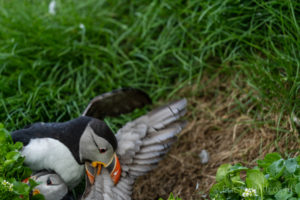Hornøya is a small island of 99 acres in Norway in the Barents Sea. It is home to around 80,000 sea birds that make their nests during the summer. In addition, the island is home to the largest gull population in all of Europe, and it certainly smells of it as you get off the boat!
The main purpose of going to the island was to see the Atlantic puffins. They return to the island during March and eventually leave around August after hatching their young. They have a black back and white underbelly and have large colorful beaks during their breeding season. They are very social birds, and I found from Googling that a group is called by many names, some of the more interesting being a circus, an improbability, or a puffinry.
The puffin was absolutely adorable to see on the island, and I had never seen any bird like it outside of zoos. They reminded me of penguins with their feather colors, but they don’t stand upright like them. Instead, they are more of a traditionally bodied bird. There are nearly 8,000 of them on the island during nesting season, and they’re all over the island in various spots! When we first got to the island, we set up not far from where we landed and starting taking photographs and kept waiting to see a puffin. After a while, we finally spotted one and started taking lots of photographs, but none that I got were great.
We started seeing a puffin peeking out from a rock here there, but nothing amazing. We started to think we were missing something when they finally started coming out along the shrubs to play and observe. There was a large group of them all scattered around the small greenery doing all sorts of things. Many just stood around gazing out at the water while some were being social or building nests. As we saw and watched them, occasionally other birds would join as well, such as the Brünnich’s Guillemots or common ones, and occasionally the European Shags.
Eventually, we started moved off to another part of the island as we had spent about an hour just around the spot that the boat left us at. We walked to the east, which walked along the island cliffs and led to two staircases. There were multiple levels that puffins were congregated at, and it was the next spot we set up shop at.
We spent almost the remaining 3 hours at just those staircases, only stopping briefly to visit the lighthouse. We ended up going to the island a second time and went straight to that spot for a full 7 hour day. We were able to rotate about the area to get different perspectives on all of the birds. While camping out in the first area, I used my tripod exclusively. But in this area, I did not need to at all, and it was great to be able to turn quickly to grab an action shot. This was my favorite area to sit in as the birds were in more green photos with the grass, and the background could be either rock, water, or foliage, depending on where I was shooting from.
Most of the puffins got along and tried to attract mates or build nests, but not all. There were also fights, some seemingly more about dominance, but not all. One fight in particular that I managed to capture was where one puffin dive-bombed the other, pulling him off the cliff and then attacking him on the ground. He was clawing at his eyes and biting him on the face and wings. Eventually, they did separate, and the one who was attacked did fly away and was hopefully okay with nothing more than a bruised bird ego.
Watching the puffins was certainly an interesting experience unlike any other that I’ve had before with wildlife. I’ve never before seen so many animals in their natural habitat all doing their own thing. It’s one thing to see the number of birds written, but it’s truly something different to see thousands of birds flying overhead as they constantly circle the island all day. Overall, both trips were fun, and I netted somewhere around 3,500-4,000 photos which I whittled down to about 60 that I ended up uploading here on the photography page!
























